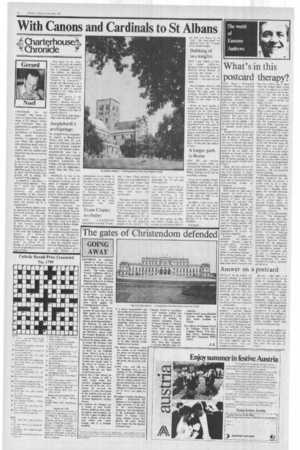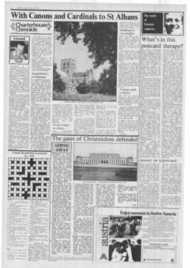Page 10, 6th May 1983
Page 10

Report an error
Noticed an error on this page?If you've noticed an error in this article please click here to report it.
Tags
Share
Related articles
Away..
Images Of A Faithful Land
I Fra Angelico Centenary
Press Exhibition Postponed The Third International...
Fighting For Christendom With Oranges And Lemons
The gates of Christendom defended
YESTERDAY an exhibition opened in Vienna to commemorate the Third Centenary of the defeat of the Ottoman armies. "The Turks outside Vienna" exhibition will be at the Kiinstlerhaus (Artists' House) and the Historical Museum of the City of Vienna until the end of October.
For two months in the Summer of 1683 Vienna, described by Islam as the "Golden Apple of the West", was besieged by 250,000 men of the Ottoman Empire. It was the last great attack against the Christian States by Islam.
Prince Eugene of Savoy became the great hero of the fight against the Turks and when Pope John Paul visits Vienna and stands on the balcony of the ImperialPalace, the Hofburg, he will look down on a splendid statue of this great prince whose palace, the Belvedere, almost rivals the Summer Residence of the Hapsburgs at Schonbrunn.
No doubt by chance rather than by design His Holiness visits Vienna on the occasion of the Third Centenary of the defeat of Islam by the Christian States. What is more, it was the efforts of Pope Innocent XI that won over the King of Poland who finally came to the rescue of Vienna. 11 is fitting that a Polish pope should visit the city three hundred years later.
Legend has it that during the Siege of Vienna in 1683 a scout, Georg Franz Kolschitzky, smuggled messages in and out of the city. As a reward he received the supplies of coffee left behind by the Turkish army and with them he established the first Viennese Kaffeehaus (Coffee House).
For centuries the Viennese sat at leisure in their Coffee Houses, drinking coffee, reading papers, and gossiping. To this day a glass of plain cold water is always served with your coffee and, oddly enough, this is a Turkish tradition. It is almost inconceivable that the traditional Viennese coffee houses should disappear and yet one by one the famous and the less famous, but no less congenial, rendezvous closed down. However, today the rise of conservationism has rescued the Viennese cafe and a revival is taking place, just in time to save some of the old ones. Visitors to the city of the Blue Danube would otherwise feel cheated.
One famous Kaffeehaus which has carried on the tradition for nearly two hundred years is Demel. As recently as 1965 Clara Demel, shortly before her death, still sat at the cashdesk.
Ladies were. and still are, the dominant force in the running of the establishment 'hod the waitresses still wear the same old-fashioned uniform and are trained carefully in a special phraseology to go with their service. Cream is still whipped by hand and pastries are of course also made by hand.
The names of Sacher (the famous gateau Sachertorle) and Htibners in the Stadtpark still evoke memories of the days of the Austro-Hungarian Monarchy. 'The Cafe Domeier, in the fashionable Hietzing district of Vienna where young Johann Strauss first played, still exists, though it no longer has the glamour of former days.
blog comments powered by Disqus











